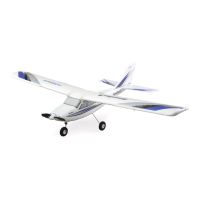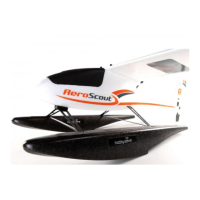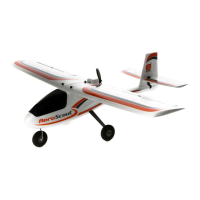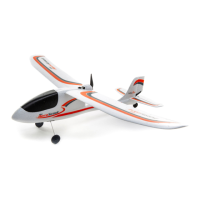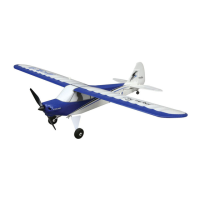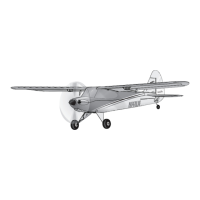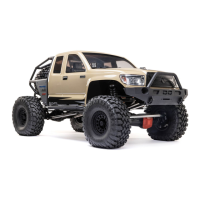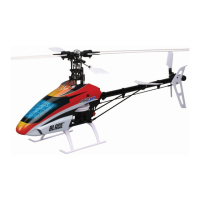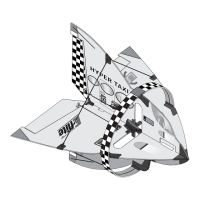Apprentice
®
STOL S 700mm
EN
25
Glossary of Important Terms
Aileron: Control surface found on the trailing edge of each wing. Giving right
aileron control causes the right aileron to deect up and the left aileron to
deect down, making the aircraft roll to the right. Giving left aileron control
causes the left aileron to deect up and the right aileron to deect down,
making the aircraft roll left.
AS3X: Active Stabilization, 3-Axis. An electronic stability system that counters
outside forces such as wind, turbulence, torque, tip-stall, control sensitivity
issues due to CG position, to make the aircraft y more smoothly, and
provide a better ying experience.
Binding: The process of electronically linking the transmitter to the receiver.
The aircraft will then recognize only a particular transmitter.
Center of Gravity (CG): Point at which the aircraft balances, most notably from
front to back.
Control Horn: An arm installed on a ight control surface to permit actuation
via an attached pushrod.
Control Throw: The distance a control surface deects, normally measured
from the widest point of the control surface.
Dual Rate: Setting found in the transmitter which allows two different control
throw distances when the control stick is deected fully. Using a low rate
gives less control throw at full deection and thus a less sensitive feel to the
aircraft. Using high rate gives greater control throw at full deection and thus
a more sensitive feel to the aircraft.
Elevator: Control surface found on the trailing edge of the horizontal stabilizer.
Up elevator causes the aircraft to pitch up. Down elevator causes the aircraft
to pitch down.
Electronic Speed Control (ESC): an electronic device that controls and
regulates the speed of the motor. It has connections from the battery, to the
motor, and to the Receiver.
Exponential: A setting programmed in the transmitter which allows the
pilot to tailor the sensitivity of the controls around neutral. Increasing the
exponential value creates a softer control feel around neutral, thus making
the aircraft less sensitive to control inputs. Exponential only affects the
controls around neutral.
Low Voltage Cutoff (LVC): A safety feature built into the electronic speed
control which activates when the battery voltage drops below a determined
level, cutting power to the motor, but still providing power to the receiver and
servos, allowing the aircraft to be landed safely.
MTOM: Maximum Take Off Mass
Pitch: The rotation of the aircraft nose up or down, controlled by the elevator.
Pushrod: A rod which is connected between the servo and control horn.
It slides back and forth to move the control surface, and may be routed
through guides or tubes to prevent exing.
Range Test: Test to check the transmitter and receiver are functioning properly.
The test is done by setting the transmitter to a low-power mode and testing
the control function from a set distance.
Receiver: an electronic device installed in the aircraft which decodes the
control inputs sent from the transmitter and sends the inputs to the servos.
Roll: Left and right rotation of the aircraft around the longitudinal axis.
Rudder: Control surface found on the trailing edge of the vertical stabilizer.
Right rudder control causes the nose of the aircraft to turn to the right. Left
rudder causes the nose of the aircraft to turn left.
Sensor-Assisted Flight Envelope (SAFE) Technology: Offers smoother
ight capability that battles windy conditions for you and multiple modes so
you can y with the level of protection and assistance that suits any given
moment of the ight.
Servo: Electronic component which translates the control signals from the
receiver into movement of a control surface. The servo is connected to the
control surface with a pushrod.
Throttle: Control input which regulates the speed of the motor. A higher
throttle setting makes the motor rotate faster, thus increasing forward thrust.
A lower throttle setting makes the motor rotate slower, thus decreasing
forward thrust.
Transmitter: Control unit held by the pilot which sends signals to the aircraft.
Yaw: Left or right rotation of the aircraft nose, controlled by the rudder.
Z bend: A Z-shaped bend at each end of a pushrod for the purpose of
connecting it to a servo arm or control horn.
AMA National Model Aircraft Safety Code
Effective January 1, 2018
A model aircraft is a non-human-carrying device capable of sustained ight within visual line of sight of the pilot or spotter(s). It may not exceed limitations of this
code and is intended exclusively for sport, recreation, education and/or competition. All model ights must be conducted in accordance with this safety code and
related AMA guidelines, any additional rules specic to the ying site, as well as all applicable laws and regulations.
As an AMA member I agree:
• I will not y a model aircraft in a careless or reckless manner.
• I will not interfere with and will yield the right of way to all human-
carrying aircraftusing AMA’s See and Avoid Guidance and a spotter when
appropriate.
• I will not operate any model aircraft while I am under the inuence of
alcohol or any drug that could adversely affect my ability to safely control
the model.
• I will avoid ying directly over unprotected people, moving vehicles, and
occupied structures.
• I will y Free Flight (FF) and Control Line (CL) models in compliance with
AMA’s safety programming.
• I will maintain visual contact of an RC model aircraft without enhancement
other than corrective lenses prescribed to me. When using an advanced
ight system, such as an autopilot, or ying First-Person View (FPV), I will
comply with AMA’s Advanced Flight System programming.
• I will only y models weighing more than 55 pounds, including fuel, if
certied through AMA’s Large Model Airplane Program.
• I will only y a turbine-powered model aircraft in compliance with AMA’s
Gas Turbine Program.
• I will not y a powered model outdoors closer than 25 feet to any individual,
except for myself or my helper(s) located at the ightline, unless I am
taking off and landing, or as otherwise provided in AMA’s Competition
Regulation.
• I will use an established safety line to separate all model aircraft operations
from spectators and bystanders.
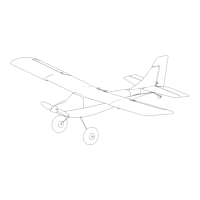
